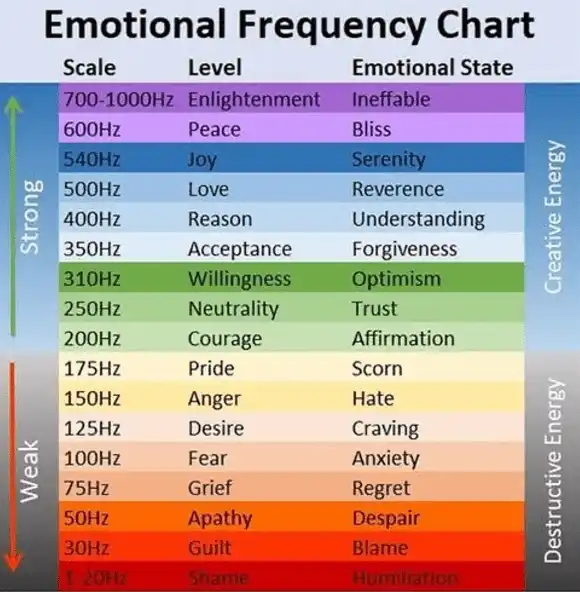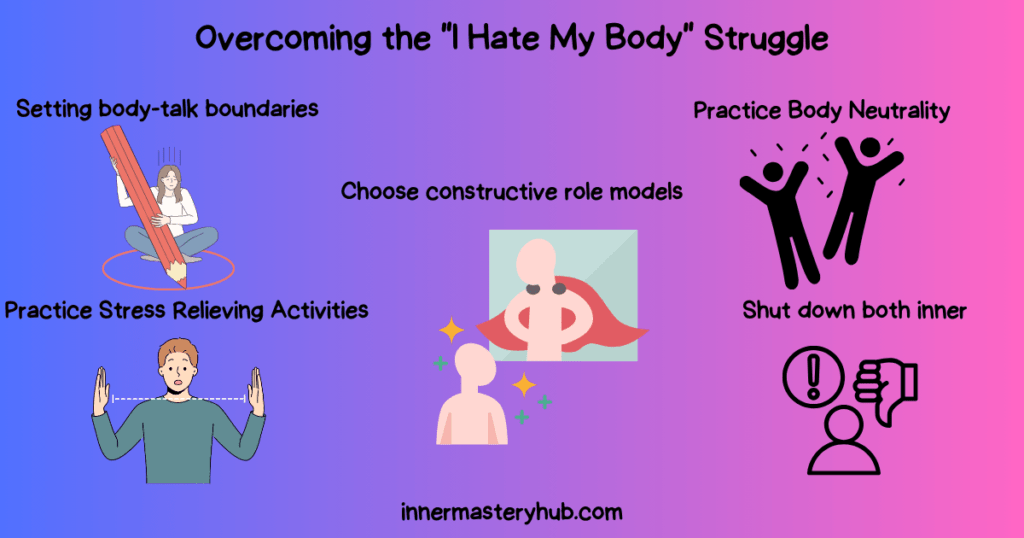Where Are You on the Emotional Frequency Chart Right Now?

Have you ever felt overwhelmed by your emotions? One moment you’re feeling high and energetic, and the next, you’re drained, unsure of how to deal with it. Many people experience fluctuations in their emotional state throughout the day, but few understand how to recognize and manage them effectively.
The Emotional Frequency Chart can be helpful in how you handle your emotions. Understand this chart to take control of your emotional health, raise your emotional vibration, and find greater peace.
Today, I’ll walk you through what the Emotional Frequency Chart is, why it matters, and how you can use it to improve your emotional well-being, and how to shift towards higher emotional frequencies.
Emotional Instability Can Be Overwhelming
We all have good days and bad days. One day you may feel full of energy and optimism, while the next day you might be filled with frustration, sadness, or anxiety. This rollercoaster of emotions is a result of not understanding how to regulate your emotional state. When we don’t know where we stand emotionally, it’s easy to feel lost or stuck.
The problem arises when we become trapped in lower emotional states for extended periods. Feelings like shame, guilt, or fear can drain our energy, affect our mental health, relationships, and even our physical health. Research suggests that prolonged negative emotions can weaken the immune system and increase stress levels, leading to chronic health issues. Without the right tools, emotional instability can take a toll on every aspect of life.
Struggling with Emotional Management
If you find yourself experiencing emotional ups and downs, it can feel frustrating. You may notice how these emotions influence your behavior and thoughts in ways that are hard to control. When you have a bad day at work, carrying that frustration home can affect your interactions with family and friends.
Or perhaps you’ve noticed how one negative thought can create a spiral of more negative thoughts, leaving you feeling trapped and powerless.
Emotional instability doesn’t just affect how you feel; it also affects your decisions. Have you ever made a snap judgment or reacted in a way that you later regretted because you were emotionally triggered? I’ve been there too, and it’s not a pleasant place to be.
That’s where the Emotional Frequency Chart comes in. It provides a roadmap to help you become aware of your emotional state and take steps to shift towards a more positive and balanced one. Instead of letting emotions control you, this chart can help you gain control over your feelings and responses to situations.
Harnessing the Power of the Emotional Frequency Chart: 4 Ways to Instant Daily Wins Chart
The Emotional Frequency Chart is a tool that categorizes emotions based on their vibrational frequency. Emotions operate on different frequencies, and understanding where you are on this scale can help you navigate your emotional world more effectively.
The idea is simple: emotions that feel good, such as love and joy, have a high frequency, while negative emotions, like anger and shame, have a low frequency.
What Is the Emotional Frequency Chart?
At its core, the Emotional Frequency Chart divides emotions into two main categories: low frequencies and high frequencies. The chart presents emotions in a spectrum from the lowest to the highest vibrations:
- Low-frequency emotions. These include feelings like guilt, fear, anger, and shame. They can drain our energy and keep us stuck in negative thought patterns.
- High-frequency emotions. These include joy, love, gratitude, peace, and enlightenment. These emotions tend to uplift us and have a positive impact on our mental, physical, and spiritual well-being.
How to Use the Emotional Frequency Chart in Daily Life
Now that you understand the basics of the Emotional Frequency Chart, let’s talk about how you can use it in your everyday life to improve your emotional health. Here are some practical ways you can apply this knowledge:

1. Identify Your Emotional State
The first step in shifting your emotional state is to become aware of your current emotional state. When you feel yourself becoming overwhelmed or reactive, take a moment to check in with yourself. Ask, “What am I feeling right now?” Are you angry? Are you anxious? Are you experiencing guilt? Understanding your current emotional state is vital to making positive changes.
For example, if you’re feeling frustrated (a lower frequency emotion), you may want to take a moment to recognize it before it spirals into anger or resentment. Acknowledging the emotion is the first step toward shifting it.
2. Shift Your Focus to a Higher Frequency Emotion
Once you’ve identified where you are emotionally, the next step is to choose a higher frequency emotion to shift into consciously. You may not be able to jump from anger to joy instantly, but you can gradually change to a more neutral or positive emotion. Begin by transitioning from frustration to acceptance or hope, and then gradually progress to joy or love.
For instance, if you’re feeling anxious, think of the things you are grateful for, which helps put your mind in a thankful state. Think of three things you’re grateful for at that moment. This simple shift can help bring you into a higher emotional state.
3. Use Techniques to Raise Your Vibration
To help make these emotional shifts easier, incorporate practices into your daily life that raise your emotional frequency. Here are some techniques that I’ve personally found helpful:
Meditation. Meditation can help calm the mind and improve your emotional state. A few minutes of deep breathing or guided meditation can help you access higher states of consciousness.
Positive Affirmations. Affirmations are powerful statements that can help reprogram your mind and shift you into a more positive emotional state. Try saying something like, “I am in control of my emotions, and I choose peace.”
Physical Activity. Exercise releases endorphins, which are natural mood boosters. Even a short walk of 15 minutes outside or just spending some time in nature can help clear your mind and raise your vibration.
Gratitude Journaling. Keep a gratitude journal to focus on the positive aspects of your life, which naturally boosts your emotional frequency.
Using the Emotional Frequency Chart in Action
Let me share a personal example of how the Emotional Frequency Chart has helped me. A few years ago, I was going through a rough patch. I felt stressed at work, had difficulty sleeping, and found myself constantly feeling anxious and overwhelmed. I would often find myself stuck in negative thought patterns.
One day, I came across the Emotional Frequency Chart, and it completely changed my perspective. I started paying more attention to my emotional state and realized that I was often operating from a place of fear and anxiety (lower frequencies).
Once I identified where I was on the chart, I began practicing techniques such as meditation, deep breathing, and focusing on things for which I was grateful. Slowly, I began to shift my emotional state, and I started to feel better. My relationships improved, my work performance improved, and my overall outlook on life became more positive.
The Impact of Emotional Frequency
Research has shown that our emotions have a profound impact on our well-being. For example, Dr. David R. Hawkins, the author of Power vs. Force, created a scale that maps the vibrational frequencies of emotions. According to his research, emotions such as shame, guilt, and fear have low energy, while emotions like love, joy, and peace have high energy.
Studies also show that maintaining a positive emotional state can improve physical health. According to research published in the Journal of Psychosomatic Medicine, people with positive emotions tend to have better immune function and lower levels of stress hormones.
On the other hand, chronic negative emotions can lead to higher levels of inflammation, which is linked to various health conditions, including heart disease and autoimmune disorders.
Taking Control of Your Emotional Health
Understanding the Emotional Frequency Chart is a helpful way to help you take control of your emotional health. Become aware of your emotional state, shift to a higher frequency, and use daily practices to elevate your vibration. You can improve your mental, physical, and spiritual well-being.
Emotions are a natural part of life, but we don’t have to be controlled by them. By learning to manage the emotional spectrum and raising our emotional frequency, we can live healthier, happier lives. Give it a try – you’ll be amazed at how much of an impact this simple chart can have on your life.
Frequently Asked Questions (FAQs) about Emotional Frequency Chart
What is an Emotional Frequency Chart?
An Emotional Frequency Chart categorizes emotions based on their vibrational frequency. Emotions like love and joy are high-frequency, while emotions like fear and guilt are low-frequency. Understanding this chart helps you manage and elevate your emotional health.
How can I use the Emotional Frequency Chart in daily life?
To use the chart, recognize where your emotions fall. Shift from lower frequencies, such as frustration, to higher ones, like acceptance or love. Practices such as meditation and gratitude can help elevate your emotional state.
Why is emotional frequency important?
Emotional frequency impacts mental and physical well-being. Higher frequencies promote health, happiness, and peace, while lower frequencies can lead to stress, anxiety, and physical illnesses.
Can I instantly shift my emotional state?
It’s possible to shift your emotional state, though it may take practice. Gradually moving from negative to positive emotions through mindfulness techniques, such as deep breathing, helps you raise your emotional frequency.
What are examples of low-frequency emotions?
Low-frequency emotions include guilt, shame, fear, anger, and sadness. These emotions can drain energy and perpetuate negative thought patterns, which can impact both health and relationships.
What are high-frequency emotions?
High-frequency emotions include love, joy, gratitude, peace, and enlightenment. These emotions have a positive impact on our health, improving mental clarity, emotional stability, and physical well-being.
Can the Emotional Frequency Chart improve my relationships?
Yes, understanding the Emotional Frequency Chart helps you recognize and regulate emotions, leading to healthier communication and better emotional management in relationships.
What role does the Emotional Frequency Chart play in mental health?
The chart helps identify emotional states, allowing you to shift from negative emotions to more positive ones, which can reduce stress and improve overall mental health.
Is there scientific evidence supporting emotional frequencies?
Yes, research indicates that emotions have a measurable impact on our physical health. Positive emotions enhance immune function, while negative emotions can increase stress and inflammation, affecting health.
How can I quickly raise my emotional frequency?
Techniques such as deep breathing, positive affirmations, and practicing gratitude can help you quickly shift to a higher emotional frequency. Exercise and meditation are also effective methods for elevating your emotional state.






